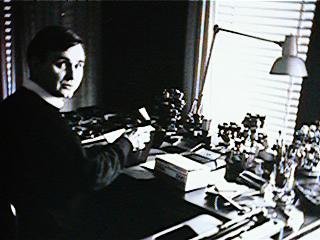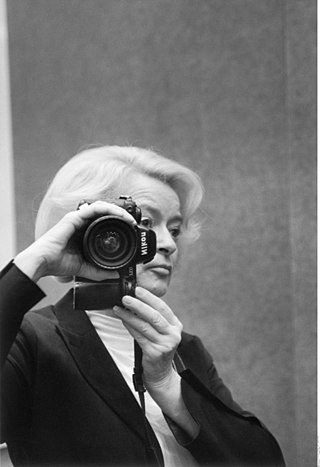
Andy Warhol was an American visual artist, film director and producer. A leading figure in the pop art movement, Warhol is considered one of the most important American artists of the second half of the 20th century. His works explore the relationship between artistic expression, advertising, and celebrity culture that flourished by the 1960s, and span a variety of media, including painting, silkscreening, photography, film, and sculpture. Some of his best-known works include the silkscreen paintings Campbell's Soup Cans (1962) and Marilyn Diptych (1962), the experimental films Empire (1964) and Chelsea Girls (1966), and the multimedia events known as the Exploding Plastic Inevitable (1966–67).

Fax, sometimes called telecopying or telefax, is the telephonic transmission of scanned printed material, normally to a telephone number connected to a printer or other output device. The original document is scanned with a fax machine, which processes the contents as a single fixed graphic image, converting it into a bitmap, and then transmitting it through the telephone system in the form of audio-frequency tones. The receiving fax machine interprets the tones and reconstructs the image, printing a paper copy. Early systems used direct conversions of image darkness to audio tone in a continuous or analog manner. Since the 1980s, most machines transmit an audio-encoded digital representation of the page, using data compression to transmit areas that are all-white or all-black, more quickly.

Performance art is an artwork or art exhibition created through actions executed by the artist or other participants. It may be witnessed live or through documentation, spontaneously developed or written, and is traditionally presented to a public in a fine art context in an interdisciplinary mode. Also known as artistic action, it has been developed through the years as a genre of its own in which art is presented live. It had an important and fundamental role in 20th century avant-garde art.

Joseph Heinrich Beuys was a German artist, teacher, performance artist, and art theorist whose work reflected concepts of humanism, sociology, and, with Heinrich Böll, Johannes Stüttgen, Caroline Tisdall, Robert McDowell, and Enrico Wolleb, created the Free International University for Creativity & Interdisciplinary Research (FIU). He previously in his talks and performances also formed The Party for Animals and The Organisation for Direct Democracy. He was a member of a Dadaist art movement Fluxus and singularly inspirational in developing of Performance Art, called Kunst Aktionen, alongside Wiener Aktionismus that Allan Kaprow and Carolee Schneemann termed Art Happenings. Today, internationally, the largest performance art group is BBeyond in Belfast, led by Alastair MacLennan who knew Beuys and like many adapts Beuys's ethos.

Postmodern art is a body of art movements that sought to contradict some aspects of modernism or some aspects that emerged or developed in its aftermath. In general, movements such as intermedia, installation art, conceptual art and multimedia, particularly involving video are described as postmodern.

Eduardo Kac is a Brazilian and American contemporary artist whose portfolio encompasses various forms of art including performance art, poetry, holography, interactive art, digital and online art, and BioArt. Recognized for his space art and transgenic works, Kac works with biotechnology to create organisms with new genetic attributes. His interdisciplinary approach has seen the use of diverse mediums, from fax and photocopying to fractals, RFID implants, virtual reality, networks, robotics, satellites, telerobotics, virtual reality and DNA synthesis.

Telematics is an interdisciplinary field encompassing telecommunications, vehicular technologies, electrical engineering, and computer science. Telematics can involve any of the following:
Kenneth Atchley is an American composer, noise and drone musician, video artist, and member of the San Francisco Bay Area electronic music community.

Kaii Higashiyama was a Japanese writer and artist particularly renowned for his Nihonga style paintings. As one of the most popular artists in post-war Japan, Higashiyama was awarded the Japan Art Academy Prize in 1956 and the Order of Culture in 1969.

Thomas Hirschhorn is a Swiss artist who lives and works in Paris.
Telematic art is a descriptive of art projects using computer-mediated telecommunications networks as their medium. Telematic art challenges the traditional relationship between active viewing subjects and passive art objects by creating interactive, behavioural contexts for remote aesthetic encounters. Telematics was first coined by Simon Nora and Alain Minc in The Computerization of Society. Roy Ascott sees the telematic art form as the transformation of the viewer into an active participator of creating the artwork which remains in process throughout its duration. Ascott has been at the forefront of the theory and practice of telematic art since 1978 when he went online for the first time, organizing different collaborative online projects.
Social sculpture is a phrase used to describe an expanded concept of art that was invented by the artist and founding member of the German Green Party, Joseph Beuys. Beuys created the term "social sculpture" to embody his understanding of art's potential to transform society. As a work of art, a social sculpture includes human activity that strives to structure and shape society or the environment. The central idea of a social sculptor is an artist who creates structures in society using language, thoughts, actions, and objects.

Internet art is a form of new media art distributed via the Internet. This form of art circumvents the traditional dominance of the physical gallery and museum system. In many cases, the viewer is drawn into some kind of interaction with the work of art. Artists working in this manner are sometimes referred to as net artists.
Robert Adrian (1935–2015), also known as Robert Adrian X, was a Canadian artist who made radio and telecommunications art. Adrian moved from Canada to Vienna, Austria in 1972 where he became known for creating experimental artworks using radio and communications technologies. His work The World in 24 Hours, which connected artists in different cities and continents through telephone lines and radio, is considered to be one of the first experiments in online culture. Adrian is considered to be a pioneer in the field of telecommunications art and media art.

New media art includes artworks designed and produced by means of electronic media technologies. It comprises virtual art, computer graphics, computer animation, digital art, interactive art, sound art, Internet art, video games, robotics, 3D printing, immersive installation and cyborg art. The term defines itself by the thereby created artwork, which differentiates itself from that deriving from conventional visual arts such as architecture, painting or sculpture.

Guy Bleus is a Belgian artist, archivist and writer. He is associated with olfactory art, visual poetry, performance art and the mail art movement.
Norie Neumark is a sound and media artist who lives and works in Melbourne, Australia. She is part of the art group Out-of-Sync, an art collaboration with Maria Miranda.

Antje (-Maria) von Graevenitz, born Ludwig is a German art historian, art critic, educator and author.

Angelika Platen is a German photographer known internationally for her portraits of artists.
Karen O'Rourke is an artist and Emeritus Professor at Jean Monnet University in Saint-Etienne. Her personal work tends to relate artistic practice with the notion of network with that of archiving and with that of territory. She has published numerous articles in journals and collective works. She is the author of two synthesis books; Walking and Mapping: Artists as Cartographers and From the arts-networks to programmed drifts: current events in “art as experience”.














